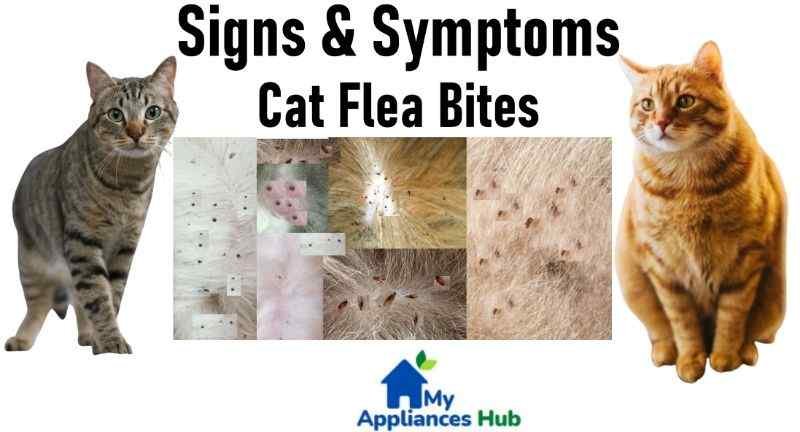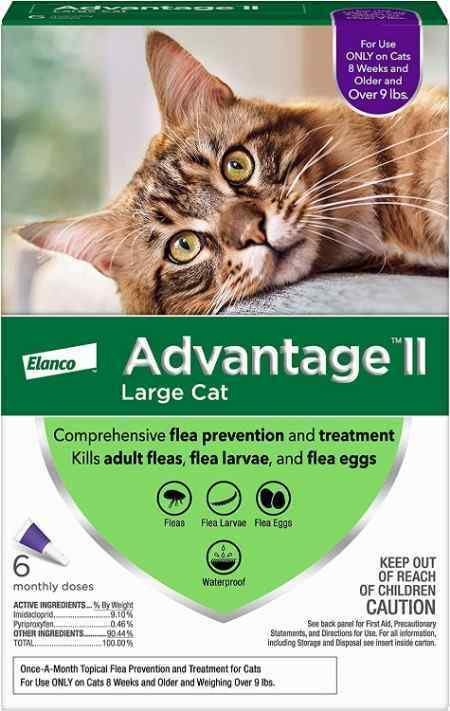Here is all about cat flea bites and what they look like. In this article, you will learn: what flea bites on cats look like (both infected and ordinary cat fleas bite), what attracts fleas to bite cats, how cats get fleas, the symptoms and signs of cat flea bites, and the danger of flea bites on a cat, what happens if cat fleabites humans, the risk of flea bites scabs on cats, fast way to check flea on cats, how long can flea bite last on a cat, and how to avoid mistaken flea bites for bug bites on cats.
The cat flea bites may appear in a straight line (just like human flea bites) or a cluster. The cat flea bites may also look like tick bites, but flea and tick bites are entirely different with proper observation. The neck and back are part of the cat’s body where fleas usually bite cats. Groin, belly, head, ears, the base of the tails, and your cat legs’ backside.
The reaction and effect of flea bites vary from cat to cat. Some are better immune and are allergic, while others can not handle the impact, including itching, scratching, biting, chewing, and grooming. Your cats can get sick from flea bites infections due to injection of saliva that result in skin scabbing, inflammation, and sometimes hair loss.
Please read on.

Must Read Articles
- Flea Bites on Humans: What Do Fleabites Symptoms Really Look Like?
- How to Catch and Use Sand Fleas (Mole Crab) for Baiting Fish
- Flea Bites On Dogs: What Do Fleabites Symptoms Look Like on Dogs?
- What Do Sand Fleas Look Like? Top Discoveries About Fleas in Sand
- What Do Sand Flea Bites Look Like? Symptoms, Prevention, and Treatment – Tungiasis
Support for Cat Flea Bites Allergy, Skin Itchy, and Scratching Relief Products
HomeoPet Feline Skin and Itch, Coat and Skin Relief for Cats (15 Milliliters)

GoPets Dematting Flea Comb For Grooming and Checking for Cats Fleas Bites (2 Sided)

Hartz Groomer’s Flea Comb for Checking and Removing Cats

FRONTLINE Plus Flea Treatment for Cats

Veterinary Formula Clinical Care – Cat Flea Itch Relief Medicated Spray/Shampoo

PetArmor Plus Cat Flea Bite Prevention – Fast Acting and Long Lasting (Cats Over 1.5lbs)

Bayer Seresto Cat Flea Collar – All Weights (2 Pack)

Hartz UltraGuard Pro Flea Collar for Cats and Kittens, 7 Month Flea Prevention & Protection (1 Collar)

Advantage II Flea Prevention & Treatment for Large Cats (Over 9 Pounds)

What Do Flea Bites Look Like On Cats?
What do flea bites look like on cats’ skin? Flea bites on cats look like tiny red-pink dots like a red ring around them. The cat flea bites can result in small pinkish or reddish color bumps in the form of raised rashes that are incredibly itchy. It often forms in clusters of two or three that appear bumpy, especially after vigorous scratching of the affected location on the cat’s body part.
What Do Cat Flea Bumps Look Like on Cats?
Why does my cat have bumps on her skin? Do cat flea bites cause spots? Can flea bites cause bumps on cats? Yes, fleas bite lumps or bumps are caused by an infection that results from cat skin puncture due to excessive scratching of the affected part of the cat skin. The bumps are cysts caused by the damage and blockage of the cat’s hair follicle that clogged the cat’s skin (bacterial skin infection in cats or skin pores). These Sebaceous cysts in your cat are harmless, noncancerous, and fluid-filled sacs that are benign (do not spread to other parts of the cat’s body).
What does a flea rash look like on a cat? Why do flea bites have a red bump? The release of skin histamine in cats causes the cat fleabites to swell that form the rash red bump look commonly seen in flea bites. This also happens in mosquito bites. It is the reason why bug bites look similar.
What Do Flea Bites Look Like on Kitten?
Do the flea bites look the same on both cats and kittens? How can I identify what flea bites look like on kittens? The look of flea bites on kittens is almost the same on cats. The edges appear more like tiny pink dots or small red but are still raised above the skin and crusty in the center. The kitten bites form in more than two clusters, with each dot with a tiny red ring around it just like the adult cats but now appear smaller.
Can baby kittens have fleas? Can fleas hurt newborn kittens? Fleas are blood-sucking parasites that constantly seek a host animal to feed on, either big or small, just like kittens. Fleas do not select their host to provide on. All it desires is a host with vibrant blood like a kitten. The problem is that most kittens are at risk of getting flea anemia due to loss of blood from the fleas feeding because they are young and small in size.
Can a newborn kitten have flea bites? Yes, it is the reason you should care for your kitten to avoid cat flea infestation by all means, because newborn kittens can also have flea bites that can be dangerous.
How fast can cats’ flea bites cause anemia in kittens? What causes anemia in kittens? A severe infestation on a very young kitten can cause it to become seriously anemic. Usually, fleas feeding on the blood of a cat host can result in low red blood cell counts that can make the kitten sick.
Where Do Cat Fleas Come From?
Where did cat fleas come from? What is the origin of cat fleas on cats, humans, homes, and houses? Cat fleas (Ctenocephalides felis) are researched to have originated in Africa, and they are now found globally and in most countries of the world. The human domestication of cats causes the increase and spread of cat fleas today.
What species of fleas are in the US? What makes cat flea bites dangerous to humans and pets (dogs and cats)? Although cat flea can be found worldwide, it is the most common domestic flea found mostly in homes and pets in the United States. This cat flea (Ctenocephalides felis, i.e., Bouché) will always remain on the host because of its parasitic nature and the need for fresh blood of its host as a meal for it to reproduce. Cat fleas (Ctenocephalides felis) is accounted for between 92 to 99% of fleas found regularly on cats and dogs in North America. The dog fleas Ctenocephalides canis (Curtis) are commonly found in Europe.
How Do Cats Get Fleas?
How do indoor cats get fleas with no other pets? Where are my cat’s fleas coming from? Can indoor cats still get fleas? Most of the time, your cats catch fleas via contact with other pets, domestic, and wild animals such as rats already infected with fleas. Your cat can get fleas indoors even with no other pets around or without going outside. It is typical for fleas to hop from one animal to another because they are crafty and resilient critters. It is how your cats may get infected with fleas through other pets that live close to you in multifamily buildings, complexes, and apartments.
How Do Kitten Get Fleas Bites
How many fleas can live on a kitten? There are so many ways kittens can get fleas, but the most common ways are from carpets, your bedding, home furniture (chairs), other pets, and humans. The kitten can also get fleas through flea eggs that can be dormant anywhere in your home and apartment. An infested kitten can have any number of fleas living on them. A kitten can support as many as over 300 fleas, and you should be sure that fleas won’t abandon their host because of the high population of a host unless the host is dead.
Other Ways Cats Can Pick Up Fleas
Where can cats also pick up fleas? Where do cats pick up fleas? Cats can also pick up fleas inside and outside your homes and apartments. Both indoor and outdoor cats can contact and get infected with fleas. Your indoor cats can pick up fleas directly from you or your household since fleas can hob and hitch into your house and home via your clothes.
Where Can cats get fleas from? There are different ways fleas infestation and migration can happen, and your indoor cats can get them when to varying stages of the flea life cycle, such as adults, eggs, larvae or pupae, etc. These are six potential flea transmitters and other ways your indoor cats can get and pick up fleas:
- Other pets (either yours or your neighbor’s pet) can bring fleas into your indoor cats.
- Your friends and family can transport fleas to your indoor cats and apartment without knowing.
- Through wild animals and rodents such as rats, fleas can get into your home and apartment.
- Your cats can pick up fleas from your veterinary doctor
- Your indoor cats can also get fleas infestation when you move into a new home and apartment.
- Second-hand items bought from stores (i.e., flea markets) can be a source of flea transmission into your indoor cats.
Can Cats Get Fleas From Backyard Grass?
Can cats get fleas from grass outdoor? Will cats pick up fleas from backyard grass? Whether you are part-time outdoor or entirely outdoors, cats can easily pick up and attract fleas when they:
- Climb a tree.
- Walkthrough tall grass.
- Go through your yard.
- Hide and hide, playing in the shrubs.
You need to know that most cats and dogs get infected with fleas when roaming outside. According to research, there is some evidence that fleas live in the grass and prefer a moist, humid, and outdoor environment.
But, can cats get fleas if they live outside? Most cats that live indoors and outdoors are prone to fleas infestation in your homes and apartments. And if your cats live fully outside your home, they will be exposed to getting fleas as they roam around the barns, garages, backyard, and lawn.
Do Fleas Live in Backyard Grass?
Where do fleas live outside your homes? Where are fleas before they hob onto cats? Fleas are understood to live in sand, debris, woodpiles, sheds, and high grass in your yard and in wildlife such as an area that is very close to the soil, moist, humid, and shady areas to avoid sunlight and heat. It is the reason many believe that fleas can thrive in lawns and yards with moderately tall grass while they wait to get a host to hob into.
Can Cats Get Fleas in the Winter?
Do cats get fleas in the winter? Can a cat get fleas in the winter? Yes, your cat can have fleas in the winter, but with a lower chance because fleas remain dormant during the winter season. In winter, an indoor cat in a warm environment in the house due to central heating will attract more fleas. According to Oklahoma State University academic research work, fleas have proven to stay active and will bread all year round in excellent heating conditions in wintertime. An indoor cat can get fleas in the winter months as they don’t encounter so much cold.
But do outdoor cats have fleas in the wintertime? Can fleas live on outside cats in winter? Yes, your outdoor cat can have fleas in the winter, irrespective if the cat is domestic or feral. The adult fleas will continue to suck the blood, feed, and bite their host in the winter. It is how they reproduce and multiply by laying hundreds of eggs daily in wintertime. The winter may make fleas have longer life cycles.
Can Fleas Live on Outside Cats in Winter?
Can fleas live on outdoor cats in winter? At what temperature do fleas die on outdoor cats? Fleas on outdoor cats can comfortably live and survive in the winter as low as 33°F for 5 days. Adult fleas will die at a temperature lower than 46.4°F ( for as long as ten days), while flea eggs and larvae on outdoor cats will die at a temperature lower than 55.4°F.
How Long Can Fleas Eggs Lay Dormant on Cats In Winter?
How long can fleas eggs lay dormant in the winter months? Can adult fleas lay dormant in the winter months? How long can a flea be dormant? Yes, an adult flea can remain dormant during winter for 100 days without sucking blood from its host. While flea larva can also remain dormant inside the flea cocoons for up to 9 months, they can survive and live through the winter inside various debris provided by their host.
How long a flea stays dormant in winter depends on the environmental condition and the situation of its host. Fleas may also lay dormant outdoors in winter in the garden, under your carpet, and in your furniture at home.
Do Feral Cats Have Fleas in the Winter?
Do feral cats have fleas in winter? Can all stray cats have fleas? Why do feral cats have fleas in the wintertime? Stray and feral cats will have fleas, especially if they live exclusively outside. They will be exposed to fleas all the time because they will feed and interact with other animals. This is why stray kittens will usually have fleas and worms.
Can a feral cat not have fleas in winter? If you have feral or stray cats near your home or are exposed to any during winter or otherwise, expect your feral cats to interact and mingle with your cats and pets indoors constantly.
Cat fleas do not disappear in wintertime (especially adult cat fleas). During winter, they will constantly adapt and infect other cats and pets by hopping from one pet to another while they lay eggs to multiply and survive. However, according to research and findings, it is yet to be known that cat flea eggs, larvae, and pupae will survive outdoors in the wintertime.
What Attracts Fleas to Bite Cats?
What attracts fleas to cats? Several factors work together in unison that help fleas detect a suitable host. Fleas get drawn to their host through warmth, darkness, food, air movement, and exhaled carbon dioxide (CO2). During the cat fleas’ host findings, fleas are attracted to the visual and thermal stimuli of heat and light radiation from their host.
Are cat fleas attracted to heat or light? Fleas must seek a blood meal within seven days of their release from their cocoon, or they starve to death. Studies have proven that over 90% of cat fleas will hop toward the lighted area in less than an hour. Visual and thermal stimuli reinforce a suitable host detection when fleas seek food.
Green-yellow coated light has attracted more fleas than any other color light. Hence the flea’s attraction towards colored light is boosted when the light is turned on and off in quick succession for split seconds.
Some studies concluded that the interruption of colored light mimics the shadow and movement of cat fleas’ host, making the fleas jump toward the perceived food source. Fleas traps (for flea control and prevention) that use the flea’s attraction to intermittent lightning are known to capture more fleas (82%) compared to those traps with a constant light source (10%).
Factors that Aid and Attracts Fleas to Cats
What attracts fleas to cats? Why do cats get fleas? Cat fleas want and need a host to live, feed, and reproduce. And cats get fleas because they provide the amenities for fleas to live and reproduce. An original study by Flernoy G. Jones of the Department of Entomology of the University of Missouri Extension stated that adult fleas would instantly recognize the presence of a potential host by sensing odor, heat, and air movement.
Therefore, some factors drive cat fleas’ responses and reactions to a potential host. The factors that help cat fleas dictate the selection and attraction to potential and active hosts are:
- Flea Gender,
- Flea Age,
- Host Abandonment
- Cocoon Emergence
- Host Size
- Host Color
- Time of Day
- Gravity (Geotaxis)
- Light
- Colour of Light
- Intermittent Light
- Air Currents
- Carbon Dioxide etc.,
Why Flea Bites Is Dangerous on Cats
What makes cats flea bites dangerous to cats? Why are cat fleas hazardous for cats? How complex are cat fleas bites on cats? Cat flea bites are dangerous because they are painful skin wounds and very itchy for any cat, and they can cause your cat enormous problems such as Flea Allergy Dermatitis – FAD. Flea Allergy Dermatitis is an immunologic disease caused by an allergy to flea saliva (as a result of injection of antigens via the salivary glands) as fleas feed on your cats’ blood. If flea allergy dermatitis is not treated in cats, it can result in secondary skin infections, resulting in more complications.
What Does Flea Bite Dermatitis Look Like?
What are the symptoms of flea allergy dermatitis in Cats? The flea allergy dermatitis in cats’ skin appears small but red (erythema) with small bumps (also called crusts and papules). Itching, hair loss, and excessively grooming are major clinical clues that your cat may be suffering from FAD. You may observe your cat licking, chewing, and scratching the affected portion of the skin which usually results in open sores or scabs on cat skin, which may leads to secondary infection and bacterial attack.
Can a cat fleas infestation make a cat sick? What illnesses can fleas cause in cats? Yes, a cat can get sick via cat fleas saliva, resulting in scabbing, hair loss, and skin inflammation. Cat fleas infestation can transmit serious illnesses such as cat scratch disease (i.e., infection with Bartonella) that can further spread to pets (like dogs), children, humans, and even animals at home. Other cat fleas bite illnesses can include intense skin irritation at the bite locations, intense skin irritation, hair loss around the belly, inner thighs, and cattail, etc.,
But can cat fleas bite cause kidney failure in cats? Can cats get an infection from fleas? Cat fleabites can cause flea-related feline diseases such as swollen joints, fever, and lack of or decreased appetite. Cat fleas can spread, carries, and transmit murine typhus, the bubonic plague, tularemia, and even tungiasis. Also, a fleaborne disease resulting from a lack of proper treatment can lead to a severe feline illness that may include joint damage, neurologic dysfunction, cardiac problems, and kidney failure in cats.
Why Cat Flea Bite is Dangerous to Humans and Children
Can cat fleas cause harm to humans? Are cat fleas dangerous for people? Can humans get sick from cat flea bites? Yes, cat fleas can be difficult and harmful to humans because they may spread severe and fatal diseases. Though the risks of cat flea bites resulting in complications are rare, but can usually cause a lot of discomfort and irritation due to itching and scratching. Excessive scratching can contaminate the skin, leading to bacterial infections that make people sick.
Can cat fleas transmit diseases to humans? Can cat fleas cause illness in humans? Yes, cat fleas can carry and transmit severe conditions to humans, especially children, and kids. Cat scratch disease (CSD) can be found in any infestation of fleas in cats. Potential illnesses distributed among cats include plague and typhus, which transmit CSD with Bartonella, which cats can further spread to humans and kids.
Can Cat Flea Bite Transmit Diseases to Humans and Children?
Which disease can result from the bite of an infected cat fleas bites? Fleaborne typhus disease is caused by Rickettsia typhi bacteria and can spread to people with contact with infected cat fleas. If an infected flea is accidentally swallowed by parasites such as tapeworms, it will apply to humans, children, pets, and animals. Kids and children are at risk because they often play close to the floor, are carpeted, and have pets where they can quickly get cat fleas. Fleas can get infected if they bite infected cats, opossums, dogs, or rats.
In the United States, some cat fleas carry pathogens that can lead to human fleaborne diseases. It is categorized by the Centers for Disease Control and Prevention (CDC) as stated below.
Plague Disease
This is a disease that has an impact on humans and animals. It is caused by a bacteria called Yersinia pestis. People often get infected by this disease if they get bitten by an infected ground squirrel fleas and rodent fleas (Oropsylla Montana and Xenopsylla cheopis, respectively), i.e., a rodent that is already infected with a plague bacterium.
The plague was said to have killed many people in Europe during the Middle Ages (i.e., 13th, 14th, or 15th centuries ago).
However, an effective antibiotic can treat and clear off the plague today. Lack of prompt treatment of this disease can result in death. The death resulting from plague infections is widespread in Asia and African regions, while some cases can be seen in the rural areas in the US. Other diseases related to cat fleas bites as categorized by the Centers for Disease Control and Prevention (CDC) are:
- Flea-borne (murine) typhus
- Cat scratch disease (CSD)
- Fleaborne parasites
Are Some Cats More Attractive To Fleas Than Others?
Why do some cats get fleas and not others? Are some cats more susceptible to fleas? Are fleas attracted to some cats more than others? Some cats seem more accessible to catch flea bites because they are more sensitive to flea bites. Some cats have a high level of flea allergy dermatitis triggered by proteins in saliva injected by fleas into cats” skin when they bite to feed. Different cats have different reaction levels to Flea Allergy Dermatitis (FAD).
Some cats in a flea-infested home will experience a different response to cat flea bites. Some will experience severe irritation, while others may show no signs of flea bites. A discovery of flea bites on one cat is a sure sign that other cats and pets have fleas.
Why do some cats get more bites from fleas than other cats? Do certain blood types attract cat fleas? Can only one cat have fleas? Cat fleas (Ctenocephalides felis) will not discriminate and select blood from cats, pets, humans, animals, and even kids. Cat fleas will attack all kinds of warm-blooded mammals to feed on when in hunger. The excessive and constant scratching of the affected skin part of cats due to irritation makes it seem that cat fleas prefer such cats’ blood.
Also, some cats may have more exposed skin due to lack of fur (either bleached by the sun or deficient in the amino acid tyrosine), exposing such cats to more bitten-in heavy cat fleas infestation.
Do Cat Flea Bites Humans?
Do fleas on cats bite humans? Can cat fleas bite humans? Yes, fleas specific to cats (i.e., Ctenocephalides felis) can bite humans. Though the fleas still prefer pets to be their host, they will temporarily feed on human blood to survive. Since the adaptable habitat of cat fleas is pet and not human, they only stay on the human body for a while. They eventually move on to seek a real habitant that can accommodate them, like cats or dogs.
Can a person get fleas from a cat? Can cat fleas live on humans? Yes, people can get fleas from cats. Though cat fleas can not live in human hair, people can catch fleas from cats under a severe cat flea infestation. Cat fleas can bite humans because they need blood to live. Therefore, humans can quickly get cat fleas (Ctenocephalides felis) from cats, and they will bite humans just as they bite cats.
What Do Cat Flea Bites Look Like on Humans?
What do bites from cat fleas look like? The bites from fleas specific to cats look small, like red dots with discolored bumps and a redness ring or halo appearing around the edges. The bites may appear in two to three groups on a straight line or in a cluster of multiple bites. The cat fleas tastes tend to place around the human ankles, lower legs, and feet.
Can cat fleas cause harm to humans? What happens if a cat flea bites you? As soon as cat fleas bite humans, it releases saliva that contains an anticoagulant into the skin and blood of its host to make it easy for it to feed. The skin around the cat flea’s bites will swell due to the immune system reacting to the foreign substance (Flea’s saliva) introduced to the body. This instantly results in itchiness, irritation, and discomfort for a while but can be dangerous and harmful if the affected bitten part of the human skin is not treated timely.
What Do Infected Fleabites Look Like on Cats?
What does an infected cat’s flea bite look like? How do you know if cat flea bites are infected? Can cats get sores and skin infections from flea bites? The skin of an infected cat fleabites will often become red (i.e., erythema), may come with crusts or bumps, and will start releasing pus. You may begin to see excessive scratching, chewing, and licking of the hair of their legs due to Itching due to cat flea allergy dermatitis (FAD) or flea bite hypersensitivity. You may later see your cats having hair loss with sores and scabs at the base of their tails, head, and neck.
What does cat flea bite secondary infections look like? What secondary infections can cat flea bites cause? The secondary bacterial infection of cat flea bites may result in swelling and leakage of pus from the bitten skin that can cause serious diseases such as endemic typhus, bubonic plague, and tularemia. Secondary cat flea bite infection can also lead to many pinhead scabs distributed on the cats, darkening and skin inflammation, and an unpleasant odor of the affected portion of the skin.
Signs and Symptoms of Flea Bites on Cats
How can I tell and recognize flea bites on my cat? What are the sign and symptoms of flea bites on cats? The following are the most common and instant signs and symptoms of how to tell if your cat has fleas:
- Focus on the cat’s neck, legs, tails, and feet
- Irritated and highly itchy skin, especially at the neck
- Raised red, swollen lumps develop in less than 30 minutes of the bite
- A discolored ring around every cat flea bites
- Instant hair loss at the base of its tail and around the neck
- Non-stop and continuous scratching of the bites spot
- Biting and chewing of body, legs, and tails in an extreme frantic manner
- Excessive grooming to relieve Itching, scratching, and pain.
- You may see a black speck on your cat beddings and fur
- The cat may be restless and edgy
- The cat will start shaking or growling her head
Signs and Symptoms of Infection of Flea Bites on Cats
How can I tell and recognize the infection of flea bites on my cat? What are the sign and symptoms of flea bites infection on cats? The constant scratching, licking, and cat fleas bite, nibbling the affected part of the skin. As a result, irritation and Itching can lead to flea-related anemia. Skin lumps tend to scab over while they form blisters or minor wounds that can lead to the transmission of other parasites like tapeworms.
Can cats get a skin infection from fleas? Yes, flea bites can cause skin infections for your cats and even make your cat sick if not treated promptly. It can lead to secondary skin infections. If your cat is allergic to flea bites, it can cause Flea allergy dermatitis (FAD), which causes painful skin wounds resulting from excessive scratching from intense Itching.
The Danger of Bartonella in Cats Flea Bites
What problems can flea bites cause in cats? In cats, flea bites can also cause cat-scratch disease referred to as Bartonella henselae bacteria infections. The Bartonella infection is zoonotic such that it can be passed from animal to human, and cats and dogs can also get bartonellosis from flea bites, fly, and tick.
Do all fleas carry Bartonella? What are the symptoms of Bartonella in cats’ flea bites? Yes, fleas, ticks, mites, spiders, and even animals are positive for Bartonella. Dr. Ed Breitschwerdt of the North Carolina State University, a medicine and infectious diseases expert professor, stated that Bartonella henselae are associated with humans and animals.
What are the symptoms of Bartonella in cats? The signs and symptoms of Bartonella (cat-scratch disease) in cats as a result of fleas bites are:
- Fever
- headache.
- Fatigue.
- Poor appetite.
- Swollen lymph nodes close to flea bites or scratches.
The Risk of Flea Bites Causing Scabs on Cats
How do flea bites cause scabs in cats? Why do cat flea bites cause scabs? The risk of your cats coming up with scabs when infested with fleas is very high. Suppose your cat develops an allergic reaction (i.e., chemicals in flea saliva) due to flea bites and infestation. Any cat with flea allergy dermatitis (FAD) will experience excruciating itching, resulting in scratching, licking, or chewing the affected part of the skin. This will instantly cause hair loss, erythema (redness), scabs or sores, papules (bumps), and crusts.
Many issues can cause your cat to come up with scabs on their bodies, the problem such as skin infections with fungus or bacteria, immune diseases, overly dry skin, allergic reactions, skin parasites, etc., but the most common of them all is allergic reactions to fleas bites on the cat.
How to Check For Fleas On Cats
The best and fast way to find fleas on a cat is to have the following tools in place:
- A bow of water mixed with dish soap
- White sheet, pillowcase, or white fabric
- A fine-toothed metal flea comb or a brush
Below are quick steps you can check a cat for flea:
- Have the mixed soapy water close to your
- Get your kitten to stand on a white sheet, pillowcase, or white fabric(the white fabric will help you see any dislodge fleas or flea dirt).
- Start using the flea comb, brush, or your hands to search the cat’s coat and fur for a flea. Make sure your comb is in contact with the cat deep into the skin.
- Continue to use the flea comb even if you are not seen the fleas, be on the lookout for flea dirt, excrement, or eggs (about the size of a grain of sand or salt with cream or yellowish color).
- Also, be on the lookout for some hair loss by using the comb or brush on the cat.
- Let the cat flea dirt and excrement fall onto the white sheet. It will help you see the black specks. Some may jump and drop off onto the white towels/sheet, get stuck in the comb, and some will remain on the cat.
- To be sure that the tiny black specks are flea dirt (kitten flea feces). The flea dirt is made up of digested blood. How can you be sure that it is cat flea dirt? Kitten flea dirt will turn red when dropped and sprinkled in the water.
- Now drop the black specks on a white towel inside the bowl of soapy water. You will instantly see traces of blood (water turning reddish). That is how to find fleas fast on a cat.
- Ensure you contact your vet if you are unsure what to do and treat your kitten for flea bites.
Ways to Check For Fleas on Cats at Home
Where Do Fleas Usually Bite Cats the Most?
What part of the body do fleas usually bite in cats? Which part of a cat’s body finds flea bites? The part of the cat’s body where the flea bites the most is around:
- The neck,
- Back,
- Groin,
- Belly (abdomen),
- Cat head,
- Ears,
- Hide on the neck,
- Base of the tails, and
- At the backside of the hind legs.
You can generally spot fleas anywhere on a cat’s body and areas that allow fleas to hide, though they have refined and favorite spots. Please pay attention to your cat’s armpits and groin (where it is warm and hidden), the cat’s ears, tummy area, legs, and necks. Those are spots where you will likely find the most cat flea bites.
How Long Do Flea Bites Last on Cats?
How long does it take for cat flea bites to go away? The recovery and management of Flea Allergy Dermatitis (FAD) in cat bites can take anywhere from two weeks to less than four months. The itching and scratching due to flea bites (FAD) can take 1 to 2 weeks, but the cat recovers as soon as fleas are fully controlled. The time it takes cats to recover from flea bites depends on how long it takes to eliminate the cat flea infestation.
Why can cat flea (Ctenocephalides felis) bites take so long to go away? Can flea bites crisis in cats last for months? Flea bites in cats can last for months for some days because some cats are more sensitive than others to the cat flea saliva injection during the edges (which is the cause of Flea Allergy Dermatitis in Cats). The chemical in saliva (i.e., histamine) usually causes the redness and itching of the cat’s skin, and a single cat flea bite is enough to cause such a reaction in an allergic cat.
What happens if you leave a flea bite on a cat without treatment? Can fleas bite go away without treatment? Cat flea bites can go away on their own without treatment. But there is a need to stop the biting by fleas to prevent the continuous sucking of the blood that can cause severe anemia in cats due to heavy loss of blood.
Can Fleas Bites Be Mistaken for Other Bug Bites?
What is the difference between cat flea bites and bug bites? Bed bug bites can easily be mistaken for cat flea bites, but flea bites mostly appear smaller, raised with bright red surrounded by inflamed skin (bump). While most bed bug bites often look like that mosquito bite but with a sizeable irritated spot, bed bug bites are more significant than fleas bite and reddish but not as bright red as flea bites.
What can be mistaken for cat flea bites? Bed bug bites can be mistaken for flea bites because most bed bug bites often look like mosquito bites but with a sizeable irritating bump. Bed bug bites are larger than flea bites and reddish but not as bright red as that flea bites.
Conclusion: What do Cat Flea Bites Look Like?
You now know all you need to take proper care of your cat regarding flea bites. Regular checks and treatment for cat flea bites are vital to keeping your cat safe from cat flea infection-related sickness. It may be impossible to keep your cat out of the reach of flea bites, but you can prevent and avoid cat flea bite infection as much as possible.
You can now distinguish the difference between cat fleabites and that bugs. You know the affected area of the cat’s body to check for fleas, how long flea bites can last if your cat gets bitten, why you must prevent flea bites and scabs on your cats, and why you need to control and avoid getting bitting by cat flea bites.
Ensure you take your cats for a regular vet check to avoid serious cat flea complications. Thanks a lot for reading our article.